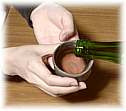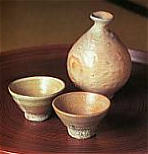|
SAKE & FOOD
Top Page
Recipes
Kasu Dishes
Etiquette
Sake Vessels 
Food & Flavor

Visit our sister
pottery center and store
Examples of
Japanese Pottery
For Sake Sipping

Polite way to hold hands |
|
 Ceramics and Sake Ceramics and Sake
Some things in life have a natural charm, the ability to draw you in and absorb your
attention to the exclusion of all else, if even for only a few moments. The combination of good sake and fine Japanese yakimono (pottery) is one such simple joy. Although there is much more to yakimono than only
tokkuri (flasks) and guinomi (cups), the overlap of this special niche of the pottery world with the world of sake buzzes with a magic all its own.
Names of Common Sake Vessels
- Tokkuri. Ceramic flask used to warm and serve sake, with a
narrow neck for retaining heat. Tokkuri come in all shapes and sizes. Click here for a pictorial guide to tokkuri shapes.
- Ochoko. Small sake cups of countless variety, color and shapes
. Cup typically broadens at neck to allow the fragrance of the sake to waft gently upward.
- Guinomi. Small cups - often fluted at the edge - a bit bigger than
ochoko. Great fun to collect as works of art. Click here for a pictorial guide to guinomi shapes.
- Masu. A square cedar box holding 180ml originally designed as a
rice measure. Most people no longer drink from masu, as the smell and flavor of the wood overpower the delicate flavors of today's premium sake.
A Quick Primer on Japanese Pottery
Although you don't need to know much about a cup or tokkuri to enjoy
its use, there is a fascinating culture just below the surface. Just like the world of sake, there are regional styles and histories evident in the character of any one piece.
There are several "schools" of Japanese pottery, all of which are focused on a region, and more importantly on the nature of the clay that is found
there. There are six main schools, or kiln, in Japan that date back to the Momoyama period. They (and their modern-day locations) are:
- Bizen (Okayama)
- Shigaraki (Shiga)
- Seto (Aichi)
- Echizen (Fukui)
- Tanba (Hyogo)
- Tokoname (Aichi)
There are others areas as well, like Karatsu and Hagi from Yamaguchi, Shino from Gifu, and Kyoyaki, a Kyoto style that came about with the
Edo lifestyle.

Each of these has there own special qualities and characteristic appearances, although there is some overlap. This is a function of not
only styles, but also the chemical composition of the clay of the region. Minerals like iron and magnesium fuse with the clay to provide different
colors and surface textures, and combine with other factors like the type of wood used to fire a kiln to provide a unique style. Some of these
styles are more porous, others are smoother, lending themselves to glazing.
Even from within the same region, mountain clay and rice-field clay give
rise to different qualities. The kama (kilns) within which the pieces are fired are vastly different as well. There are tall, climbing, multi
-chambered kilns known as "noborigama," and there are also simpler, single chambered kilns known as "anagama." Some artists fire pieces
for only a few hours, and some fire pieces for as long as several weeks. The interaction of the ash from the wood used as fuel and the clay gives
rise to the various characteristic appearances. Most of these will change color to some degree as they are used, as water and other elements impart subtle chemical reactions. For much more on Japanese sake
vessels and ceramics, please visit our sister site at www.e-yakimono
.net, which features an online pottery store.
What makes a good guinomi or tokkuri?
Naturally it is a matter of personal taste. Aesthetic appearance, weight, balance, how it feels in the hand, and a drinking lip that is not excessively rough are the general points of assessment.
A somewhat hidden feature that is always scrupulously checked by experienced collectors is the kodai, or foot, of a piece, the ring on the
bottom on which the piece rests. Lurking modestly in the background, the quality and appearance of this facet of a piece is indicative of the skill of the artist.
Size isn't everything, either. The rim of a vessel - its thickness, texture and curve - will affect how a liquid distributes itself across the tongue
and palate, thereby radically affecting the taste profile and fragrance. The artistic and aesthetic qualities as well contribute, if nothing else, by influencing the mood and atmosphere.
 The abundance of fine traditional pottery in Japan adds another
dimension to sake tasting. Beautiful tokkuri (flasks), o-chokko and guinomi (cups) help raise the nihonshu experience to a whole new level.
They just go well together; it's that simple. The culture and traditions surrounding both developed together, and it shows in the work. "Form follows function" never rang truer. The abundance of fine traditional pottery in Japan adds another
dimension to sake tasting. Beautiful tokkuri (flasks), o-chokko and guinomi (cups) help raise the nihonshu experience to a whole new level.
They just go well together; it's that simple. The culture and traditions surrounding both developed together, and it shows in the work. "Form follows function" never rang truer.
|
|
|
|